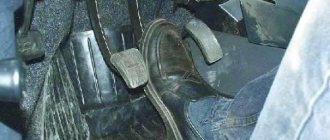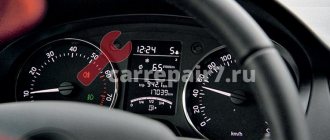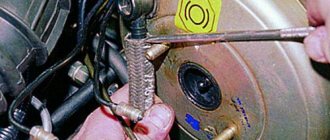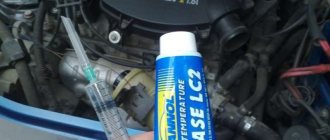Hissing when you press the brake pedal is one of the most common problems encountered in the operation of both domestic and foreign-made cars.
The thing is that most drivers react sensitively to various sounds that accompany the operation of car mechanisms. An exception is the case when a hissing sound is heard when you press the brake pedal.
But it is not always worth panicking - especially in cases where the hissing of the brake pedal when pressed does not in any way affect the efficiency of the braking system. In order to understand the nature of this sound, let's take a closer look at the operation of the vacuum brake booster.
Brakes are one of the main components of any car. And if, when you press the brake pedal, you hear hissing, creaking, the structure itself fails or, on the contrary, is too hard, you need to urgently correct the situation, do not delay or shelve possible repairs. Or at least diagnose the causes of trouble. Knowledge and understanding of the problem leads to its fastest resolution, and timely correction can save you from unforeseen situations on the road.
The level of hissing when you press the pedal - which is normal and which is not
There is a category of drivers who listen very carefully to every slightest squeak or sound and try to hear signs of a breakdown. A car is a mechanical vehicle that contains a sufficient number of components and mechanisms that can create a small permissible noise level. You shouldn’t listen too much to this and go straight to the service center, where, with a lot of persistence, they will definitely find the problem and offer to fix it. The brake pedal, when pressed, in most cases emits a slight hiss.
Vacuum brake booster for VAZ 2109
It must be said that you need to check the brakes for various noises while the car is running. In this case, windows and doors should be closed, and all devices that can make additional noise should be turned off, if possible. A small noise level in the cabin may occur due to the design of the brake system, which, as a rule, has two vacuum chambers. When you press the brake pedal, different pressures arise in them, which is why a slight hiss occurs. If it is minimal and almost imperceptible, then there will be no problems when braking.
If at idle, when you press the pedal, you hear a loud, choking sound or a strong hiss, and it is pressed tightly, then you need to look for problems. First of all, the vacuum booster is checked. A stiff pedal is not a sign of a breakdown of this part, especially in severe frost, but, coupled with hissing, it indicates the need to check it.
The brake system is constantly used by the driver, so the elements of the system are under load. Whatever driving style the driver preaches, over time it is necessary to check the brakes for serviceability. This will ensure the safety of all road users.
The vacuum amplifier has a diaphragm, which over time, like any rubber material, begins to burst and crack. This does not allow it to fully fulfill its functional purpose - to pump up the necessary pressure. The intake vacuum can also fail, but more often this is the first option.
Master brake cylinder
It is not uncommon to discover problems with the master cylinder when checking the condition of the brake assembly.
GTZ
When changing the vacuum seal, it would be logical to study the current state of the gas turbine engine and, if necessary, replace it.
Many are trying to repair the GTZ. But in practice, this only brings a temporary effect, plus you have to constantly worry whether the node will fail at the most inopportune moment. The best solution is replacement.
The replacement procedure itself is as follows.
- Disconnect the negative terminal from the battery.
- Disconnect the wire block from the fuel oil level sensor. It is located in the tank and is built directly into the lid.
- Use a special wrench for brake pipes to loosen their tension. There is no need to unscrew it completely.
- Unscrew the pair of nuts that secure the GTZ to the vacuum chamber. Only now can the brake pipes be completely unscrewed.
- Remove the cylinder from the studs.
- If necessary, remove the brake fluid reservoir itself at the same time. To do this, you need to carefully rock the tank and remove the leg from the bushing.
- Assess the condition of the removed cylinder. Also be sure to check for any defects on the tank. If there are any, be sure to replace the brake fluid reservoir with a new one.
- Armed with a new GTZ, put it in place and tighten the nuts. Fasteners can be fully tightened immediately.
- Install the reservoir and fill it with brake fluid to the maximum mark.
- Now a very important step is to extract air from the cylinder. To do this, you need to close the holes in the front brake pipes with your fingers. At the same time, your assistant should gently, but not sharply, press the brake pedal. This will create pressure in the system. Continue this manipulation until you feel liquid coming out of the holes.
- As soon as the liquid flows, put on the tubes, install and fix them in place. In this case, the brake pedal cannot be released.
- By analogy, the rear tubes are connected. When they are installed in place, there must be pressure in the system, that is, the brake pedal is pressed to the floor.
After completing the replacement of the turbocharger, do not forget to bleed the brake system according to the rules.
Disassembling the unit with the TJ tank
It is quite possible to change the vacuum seal and cylinder with your own hands. The work will take a few hours, but will save a lot of money on visiting a car service center.
Loading …
How to check the vacuum brake booster
The braking system of a car is constantly exposed to loads, and in the so-called aggressive style of driving on city streets, these loads increase exorbitantly. In general, influences of this kind are carried out constantly, even if you prefer a loyal level of speed. Therefore, the brake system must be diagnosed with enviable regularity in order to provide the motorist with the maximum degree of safety. Malfunctions in the vacuum amplifier occur, as a rule, due to the loss of condition of the diaphragm located inside this unit. It may burst or become cracked; there is also natural aging of rubber and loss of its qualities. What's the result? The diaphragm stops forming a vacuum. In some cases, the exhaust valve may also fail.
To check the functionality of the vacuum amplifier, you need to resort to the following manipulations:
- We start the engine and let it run a little at idle until the operating temperature level is reached.
- We stop the engine.
- Depress the brake pedal.
- The first movement will be no different from normal when the engine is running. The pedal must be pressed to the limit, in this case the diaphragm is set and a vacuum is formed.
- Release the pedal and press it a second time. If there are any malfunctions in the vacuum booster, then when you press it again you will feel a characteristic short pedal stroke.
- If the reaction of the braking system is the same as the first time, then everything is in order with the amplifier. When the deviations seem insignificant to you, it is worth examining the supply pipes for the presence of microcracks.
In general, each time you press the brake pedal, the engine speed will decrease slightly, however, if the difference becomes significant, it is worth visually diagnosing the hose connecting the amplifier to the power unit. If it has any defects, the collector will become leaky, and accordingly, you won’t have to count on normal mixture formation and the motor will operate unstable. The solution is simple - change the damaged hose.
Operating mode
The pump pumps water from the well, but does not turn off. Breakdowns can be different, the reasons are usually the following:
Diagram of the pressure switch device.
- The relay needs to be adjusted. For this, two small springs are used. Using a large spring, you need to adjust the lower and upper limits for turning on/off, and using a small spring, you need to adjust the pressure difference when changing such limits. Sometimes it happens that during long-term operation, wear develops and the operating pressure changes. That is why the settings already need adjustment, they differ from the factory ones. It is necessary to reduce the tension of the springs by turning them in the “-” direction clockwise. But it is not recommended to overuse this method, since the settings can be completely lost and you will have to call a technician for repairs.
- Salts with poor quality of supplied water can cause the inlet of the control relay to become clogged. In this case, the sensor stops monitoring the readings and the pump does not turn off even when the desired readings are achieved. It is necessary to stop the equipment manually, and then clean this hole.
Replacing the vacuum brake booster on a VAZ 2107 video
Brake vacuum is the most common cause. It’s another matter if the texture of the sound differs significantly from the ear. That is, the hissing turns out to be quite loud and, as it were, choking.
At the same time, when pressing on the brake pedal when it is cold, we feel its movement being excessively stiff. And also - the buoyancy of the engine speed (and sometimes it can stall). In such cases, you should pay close attention to the vacuum booster as a possible cause of the problem.
Well, a tight pedal, of course, could also be due to frost, for example, until the main one warms up. But the revs and a fairly strong hiss are already direct indicators that you need to look under the hood! How to check it?
The car's braking system is subjected to constant loads, and with the so-called sporty style of city driving, it is also subject to overloads. This happens regularly even with a measured and leisurely rhythm - there is no escape from this problem. Therefore, this unit must be regularly tested to ensure maximum driving safety for the driver and passengers. So it is with the brake vacuum story. As a rule, problems with its operation occur due to the failure of a special diaphragm located inside the device.
It bursts, cracks, and ceases to perform its duties—to create a vacuum. Sometimes the exhaust valve also malfunctions. Checking the functionality of the vacuum on their own, available to every driver, is carried out in the following way. We start the engine and let it idle for a while until it reaches ;
- We turn off the engine;
- Press the brake;
- The first press will be no different from the normal one when the unit is running.
- The pedal must be pressed as much as possible: at the same time, the diaphragm in the amplifier is extended and a vacuum is created;
A knocking or squealing noise caused by brake rotor rust that can appear overnight
You will be surprised, but rust on brake discs can appear very quickly. Especially if there is a lot of moisture outside. So don’t be surprised if you notice a layer of rust on the brake discs of your car, which has only been sitting for one night. Keep in mind that rust may cause squealing, whistling, and even knocking noises when braking.
Especially in the morning, when you are just leaving the parking lot near your house. But after a short time, this sound should go away, as the brake pads, pressed by the calipers, quickly polish the surface of the brake discs, making them shiny and smooth again.
see also
Comments 27
Hello everyone, I also have a hissing noise, but not only, if you press the car many times while the car is running, the revs drop! Is the amplifier hose the culprit? or something else?
I don’t even know how I got around to this problem.
Don’t drive, this is the correct operation of a vacuum pump with a switched off car, when you press the pedal after parking the car with the engine switched off, in the membrane cavity the pressure is equalized with atmospheric pressure and if you press the pedal through the check valve, the air is squeezed out of the manifold, which creates a characteristic hissing sound. With the engine running, This cavity is vacuum and when pressed there are no extraneous sounds, which indicates the serviceability of the vacuum and the integrity of the membrane, after the engine is turned off, the valve holds vacuum in the amplifier for some time and when the pedal is pressed, it does not make any sounds, but after parking, the sound when pressed will be repeated.
Okay, so I won’t get too worked up about this.
Don’t drive, this is the correct operation of a vacuum pump with a switched off car, when you press the pedal after parking the car with the engine switched off, in the membrane cavity the pressure is equalized with atmospheric pressure and if you press the pedal through the check valve, the air is squeezed out of the manifold, which creates a characteristic hissing sound. With the engine running, This cavity is vacuum and when pressed there are no extraneous sounds, which indicates the serviceability of the vacuum and the integrity of the membrane, after the engine is turned off, the valve holds vacuum in the amplifier for some time and when the pedal is pressed, it does not make any sounds, but after parking, the sound when pressed will be repeated.
Please tell me, I have a VAZ 2112 There was also hissing from the vacuum tank, before that the liquid was a little less than half, I topped it up but overfilled it (since everything was going back and was not visible) The next day I stopped by and bought a syringe, pumped out the liquid and now it’s exactly along the line , but there was such a problem! When I press the Brake on the move and without releasing the curls, I press it again, they seem to disappear, as if they were not pumped
When you press the pedal again, does it become hard or does it collapse? And where does the fluid go? If the wheels are dry, then look between the cylinder and the vacuum seal, there may be a main leak... then change the main one and it is advisable to change the vacuum seal as well, because the liquid most likely got on the membrane and it won’t last long enough…
The pedal becomes hard and the car barely stops. Pressing it again is normal. And this only happens on a hill or descent.
When you press the pedal again, does it become hard or does it collapse? And where does the fluid go? If the wheels are dry, then look between the cylinder and the vacuum seal, there may be a main leak... then change the main one and it is advisable to change the vacuum seal as well, because the liquid most likely got on the membrane and it won’t last long enough…
And a check was displayed, I started checking, it turned out that the mixture was lean, I was looking for where it was sucking in more air.
With the engine running, gently press the brake and listen...it will hiss and the speed should rise
Is this how you can find where the air is blowing?
If the vacuum pump is in trouble, then you will hear it... if the speed does not change and there is no hissing, then try changing the valve on the vacuum pump, the one on the hose...
With the engine running, gently press the brake and listen...it will hiss and the speed should rise
Main reasons
First, let's look at how the mechanism works when braking.
The brake system has a vacuum booster. The vacuum structure consists of a brake pedal pusher, a hose, an air and check valve and an outlet to the brake master cylinder.
When braking, the pusher acts on the air valve. The valve rises and air leaks into the amplifier. The air mass presses on the diaphragm. The latter acts on the cylinder. A hissing sound occurs when a mass of air penetrates the structure.
During operation, the diaphragm bursts, tears and does not perform its functions. In this case, air enters the structure, allowing brake fluid to enter.
Damage to the vacuum booster and air in the system is the reason why noise is heard.
Hissing when you press the brake pedal is not always a consequence of problems. A slight hiss is considered normal and does not affect the functioning of the braking system.
The design and principle of operation of the “vacuum generator”
Car vacuum booster circuit
The figure shows only a simplified circuit of the amplifier - the details of the device are, as they say, “omitted” - to make it easier to understand. What happens when you press the brake pedal while the engine is running? The brake pedal pusher simultaneously affects the booster rod and the so-called follower (in the diagram - “air” valve). The follower valve opens, and air begins to flow into the amplifier cavity, separated by a diaphragm, from the pedal side. And since a vacuum has been created in the cavity on the side of the main brake cylinder (the check valve prevents air from entering it), the air entering through the air valve begins to put pressure on the diaphragm. The latter, rigidly connected to the rod, increases the pressure on the piston of the main brake cylinder created by the driver’s foot through the pusher.
When the pedal travels when you press the brake, you can often hear a slight hiss emitted by the incoming air.
At the moment when the pedal travels, when you press the brake, you can often hear a hissing noise emitted by the air entering the amplifier housing. When the driver takes his foot off the brake pedal, the master cylinder piston and diaphragm rod return to their original position under the influence of the return springs (the vacuum booster return spring is not shown in the diagram). At the same time, since the follower valve opens only to release air (due to the fact that the driver stops pressing the pedal), it is squeezed out of the cavity by the same return spring - it also presses on the diaphragm. While the driver does not press the pedal and the engine is running, a vacuum is maintained at all times on the side of the master brake cylinder in the amplifier cavity. The monitoring valve is closed, so the diaphragm is in a state of “equilibrium”, i.e. does not have any effect on the master cylinder rod. Of course, this is only a general diagram of the operation of a vacuum brake booster, typical for all cars. On modern machines, it can be equipped with solenoids that increase the force on the master cylinder piston, and electric pumps can be used to extract vacuum. However, the operating principle of the amplifier remains the same. Let's now consider how you can check whether everything is in order if, when you press the brake pedal, you hear a hissing sound from its side.
Diagnostics
You can diagnose such breakdowns yourself. The test is carried out with the engine running.
While the engine is revving, the temperature reaches the optimum level. After this, you need to turn off the engine and depress the brake pedal all the way. The first squeeze does not diagnose breakdowns. You will need to press the pedal again... If the second time you press the pedal, you feel the pedal move hard, then you should get under the hood or take the vehicle to a service center.
In addition to carrying out these manipulations, we pay attention to the hose that goes from the vacuum to the power unit. A worn out hose indicates the need for replacement.
Troubleshooting
The vacuum amplifier is quite difficult to repair on your own, because... it is a non-separable mechanism. In order for it to work properly in the future, it is necessary to firmly connect all parts of the device , which not everyone can do.
Adjusting a repaired device requires special care. The performance of the amplifier depends on the repair. If it is not adjusted correctly, the likelihood of incomplete braking of the vehicle increases.
Damage to the amplifier cannot be repaired. In this case, the structure must be completely replaced.
How to replace the vacuum booster on a VAZ 2110-2112 if the brake pedal hisses - in the video
Malfunctions of the car brake assembly prohibit the use of the vehicle. Panic when damage occurs does not solve problems. Therefore, car owners must understand the cause of their occurrence and diagnose them correctly.
Personal experience of car owners.
“I am a driver with little experience, so it was very difficult for me to independently determine the cause of the pedal hardness. I couldn’t even figure out how to remove this or that part in order to diagnose specific problems. In the end, I took my Audi A6 to a service station. The craftsmen working there determined the nature of the damage without even removing the units. Correct diagnostics helped me significantly save on repairs.”
“When the amplifier of my VAZ 2114 broke down, I verified that it was faulty in a simple way. To do this, the hose is removed and the amplifier is turned off. The presence of a vacuum when starting the engine indicates that the “vacuum valve” is faulty.”
“The vacuum booster and cylinders are very difficult to diagnose. The best vehicle diagnostics can be provided only by those car services that have pressure gauges.”











